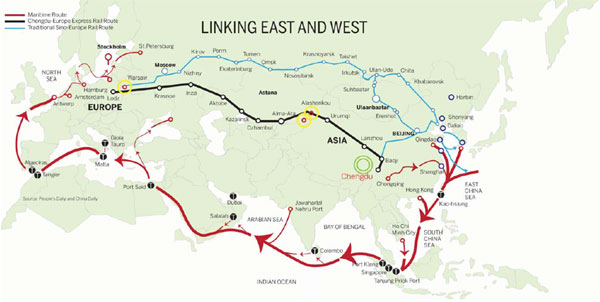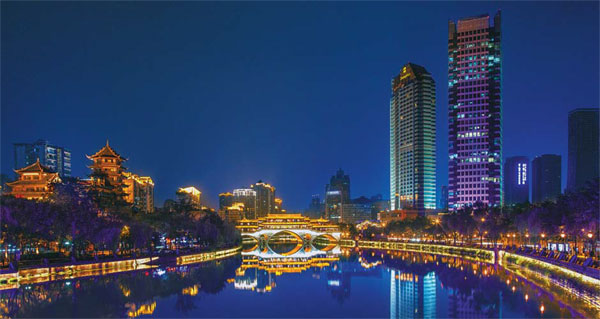A 'land port' for foreign trade

|
A night view of Chengdu, the capital of Sichuan province. Improved transport infrastructure and implementation of the Belt and Road Initiative have boosted Chengdu's opening up and development. Zhou Mengqi / For China Daily |
|
Foreign officials from 26 European countries during a visit to the Chengdu Planning Exhibition Hall last month. Photos provided to China Daily |
|
The Chengdu-Europe express railway route, which roughly follows the ancient Silk Road, sets out from Chengdu and runs to Lodz, in Poland. |
Key hub on China-Europe railway still expanding its links, Li Yang reports.
A freight train heading to Central Asia, via the Alataw Pass in the Xinjiang Uygur autonomous region departed Chengdu on July 8. On July 20, the train arrived in Lodz, Poland. Over the next three days, the commodities it had carried, mainly electronic and automobile parts made in West China and East China, were distributed to European countries such as the Netherlands, Slovakia and Germany.
On July 22, the train began its return journey; taking 14 days to travel from Duisburg in Germany, through Central Asia, to Chengdu. The freight it brought back included goods from Italy, France and Spain, including floorboards, furniture and giant panda sculptures.
Chengdu was the original starting terminus for the freight train, but in July, Xiamen became the new starting point.The railway between Chengdu and Xiamen means Chengdu now has a rail link to the sea.
In the future, export commodities from Ningbo in Zhejiang province, Shenzhen in Guangdong province and Kunming in Yunnan province will also be able to access the European market through this Eurasian Land Bridge railway.
As more and more Chinese cities link to the railway, Chengdu is becoming a key transport hub for Asia and Europe. Through its links to Ningbo, Kunming and Shenzhen, Chengdu will have easier access to the Republic of Korea, Japan, Southeast Asia, as well as the Hong Kong and Macao special administrative regions.
At the West China Expo held in Chengdu last year, Chengdu signed transport cooperation framework conventions with Kunming, Guiyang in Guizhou province, Wuhan in Hubei province and Luzhou in Sichuan province, in a bid to expand the Chengdu-Europe railway into est and Central China.
Dai Bing, professor of economics with Chengdu-based Southwest Jiaotong University, said: "Chengdu's cooperation with these cities will contribute more freight to the train, in terms of both quantity and category. Chengdu has become a 'land port' for global trade. The larger the area the port can influence, the greater its value. That's what the Chengdu-Europe railway operator is doing now."
Once the Chengdu-Europe railway is expanded to the other cities in South China and Southwest China, Chengdu's position as an important hub city connecting the Silk Road Economic Belt, 21st Century Maritime Silk Road, the Yangtze River Economic Belt, and other strategic development roads, will be strengthened. Thus, thanks to its development potential, historical legacy and unique geographic location Chengdu will become a pioneering city connecting China's foreign and domestic development strategies.
That Chengdu is the only city in the central and western parts of China to have two airports guarantees its potential to become an air transport hub in the region. And recognized by UNESCO for its spicy food and the World Tourism Organization for its places of historical interest and picturesque views, Chengdu's rich tourism and cultural resources lay a solid foundation for it to become a window city for international exchanges.
Chinese Premier Li Keqiang pointed out in his Government Work Report in March that the Belt and Road Initiative should be incorporated into China's regional development projects. Chengdu is a key point in the city clusters in the middle reaches of the Yangtze River and a center of the Chengdu-Chongqing city cluster. Chengdu is seen as having the potential to sew regional development plans onto the Belt and Road Initiative.
Another opportunity for Chengdu in the implementation of these regional integration development strategies is Chengdu can become the new home for industries transferring from East China. The relocation of relevant enterprises will further consolidate Chengdu's industrial strengths, and upgrade its industrial structure, boosting the city's foreign trade and international cooperation.
By August, 268 of Fortune Top 500 corporations had set up factories, research and development centers or regional headquarters in Chengdu.
Last year, Chengdu's gross domestic product hit more than 1 trillion yuan, up 8.9 percent year-on-year. And Chengdu's investment in fixed assets was 66.2 billion yuan, which ranked third among the sub-provincial cities.
The city manufactures two thirds of the iPads in the world, 60 percent of the world's computer chipsets and 55 percent of all laptop CPUs.
The revenue of the software service industry in Chengdu accounted for 39.5 percent of the total for the central and western parts of China. The high-tech and comprehensive bonded zone in Chengdu has attracted a number of global enterprises and research and development agencies, making it not only a robust growth point for Chengdu's economy and trade, but also an important zone for international industrial production cooperation.
Chengdu has 52 universities, 46 national-level scientific research institutes and 33 academicians of the Chinese Academy of Sciences and the Chinese Academy of Engineering.
Its patent application quantity and the number of national scientific research awards it wins each year have made it the leader among the cities in the central and western parts of China for many years.
Zhang Jinze, a professor of logistics at Southwest Jiaotong University, said, "While looking for partners at home, Chengdu should also further expand the railway in Europe, which will attract more European exporters to use the railway to transport commodities."
Trade between China and Europe at present is dominated by sea and air transportation, but Zhang says as the infrastructure develops along the railway, it will begin to take business from them.
"The railway is much faster than sea and much cheaper than air, and it is less vulnerable to weather conditions," Zhang said.
According to Wan Wenjun, deputy general manager of the Chengdu-Europe railway, in the future, the railway transport period will be 30 to 45 days shorter than transporting goods by sea, and the cost will be 20 percent that of air transport.
The Chengdu-Europe railway is an important direct freight train connecting western China and Europe. There is also a newly-opened 2,600-kilometer road connecting Chengdu with Bangkok via Kunming. About 80 percent of the fruit from Southeast Asia to Southwest China is transported via this road.
A fruit dealer surnamed Wang in Chengdu said: "It took more than 20 days to transport fruits from Thailand to Chengdu, first to Guangzhou by sea and then overland to Chengdu. Now it takes about three to four days, and the transport costs are 25 percent lower than before.."
After arriving in Chengdu, Thai fruit can be transported to neighboring Chongqing, Guiyang and Lanzhou, within three days.
Thanks to the new transport infrastructure, Southeast Asia and Central Asia have become new growth points for Chengdu's international trade.
In the first half of this year, Chengdu's total volume of imports and exports was $20.64 billion. However, Chengdu's trade with Singapore, Vietnam, Iraq and Turkmenistan rose by 21 percent, 17.4 percent, 135.8 percent and 80.9 percent respectively year-on-year. Chengdu's exports to South Africa and Brazil also grew by 70.4 percent and 1.1 percent.
The implementation of the Belt and Road Initiative has also boosted Chengdu's foreign trade. Chengdu's exports to emerging markets in the Middle East and Africa rose 9.2 percent and 32.4 percent. Because of this, Chengdu's economic reliance on the United States, Europe and Japan is declining.
Zhang Jinze thinks Chengdu's advantage lies in its complete industrial system and comparative economic power. "Chengdu was approved by the central authority to export finished automobiles recently. That will greatly promote the interaction of the auto industry between Chengdu and Europe. "
Chengdu has more than 80 international air routes to cities including San Francisco, Tokyo, London, Melbourne and Amsterdam, among other place. The city's annual passenger throughput by air is more than 30 million person times, making it the fourth largest city in terms of air transport in China.
Chengdu is also one of the most international cities in China. Sixteen consulates of foreign countries, including the United States, Germany and Australia, have been operational or approved in the city. And Chengdu is a sister city to 25 foreign cities, and has established international friendly cooperation relations with 36 foreign cities. Chengdu is also the fourth city in China, after Beijing, Shanghai and Guangzhou, to offer visa-free 72-hour transit for foreigners.
Contact the writer at liyang@chinadaily.com.cn
(China Daily 08/31/2015 page22)

















